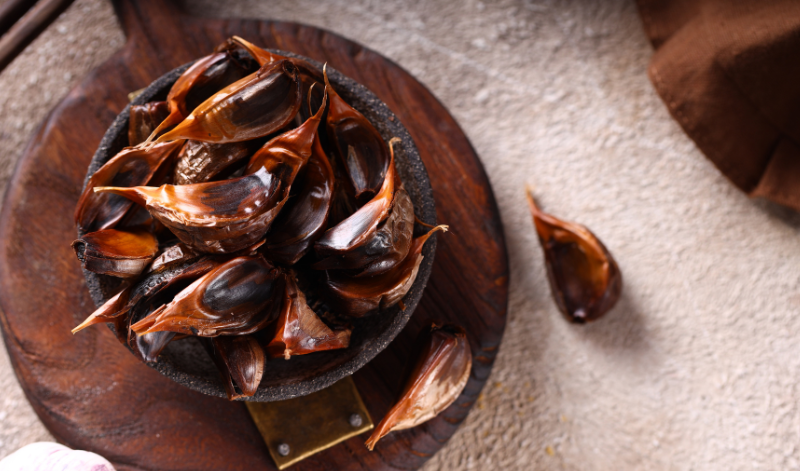Garlic: it’s the cornerstone of countless recipes, the unsung hero in sauces, sautés, and stews. But anyone who’s ever attempted to brown garlic knows how quickly things can go awry—what you meant to be golden and fragrant can turn bitter, blackened, and downright acrid. Over time, a curious myth has taken hold: that truly “burnt” garlic is not only safe but even beneficial, imparting a deeper, more complex flavor. In truth, what we’re after is not char but the gentle, sweet embrace of the Maillard reaction. Let’s unpack the science, banish the myth, and learn exactly how to coax perfect garlic every time.
The Root of the Confusion: “Burnt” vs. “Browned”
-
Burnt Garlic
-
Occurs when garlic’s sugars and proteins are exposed to high heat for too long.
-
Yields acrid, unpleasant compounds (think burnt toast or charred wood).
-
Leaves behind a bitter, almost metallic taste that can overpower a dish.
-
-
Browned Garlic (Maillard Reaction)
-
A delicate dance between amino acids and reducing sugars.
-
Produces hundreds of flavor and aroma molecules—notes of nuttiness, sweetness, and caramel.
-
The result is complex, mellow, and deeply savory without bitterness.
-
The key difference is temperature and timing. True “burnt” garlic undergoes pyrolysis (chemical breakdown via excessive heat), whereas browned garlic experiences the Maillard reaction, which occurs around 140–165 °C (284–329 °F). It’s subtle, but it’s the difference between “yum” and “ugh.”
The Science Behind the Sizzle: Understanding Maillard
-
What Is the Maillard Reaction?
-
A chemical reaction named after French chemist Louis-Camille Maillard.
-
Occurs when amino acids (from proteins) react with reducing sugars under heat.
-
Generates a cascade of flavor compounds—pyrazines, furans, and melanoidins—that create depth and color.
-
-
Why Garlic Is a Maillard Superstar
-
Contains both amino acids and natural sugars, making it a perfect candidate.
-
Thinly sliced or minced garlic exposes more surface area, accelerating the reaction.
-
Moisture content can help regulate temperature; a drop of water initially slows the heat, then evaporates, allowing the Maillard to kick in.
-
Common Myths Debunked
-
“Burnt garlic tastes better in sauces.”
Bitter garlic not only ruins a sauce’s profile but can’t be “saved” by adding acidity or sugar. If you taste a sharp, charred edge, it’s time to start over. -
“You need to get garlic as dark as possible for maximum flavor.”
Deep golden to light brown is the sweet spot. Beyond that, you’re flirting with bitterness, not complexity. -
“More heat = faster, better results.”
High heat may brown quickly, but it also jumps straight to burning. Medium-low heat and patience are your allies.
Foolproof Techniques for Perfectly Browned Garlic
-
Control Your Heat
-
Start medium-low. Let the pan warm gradually so garlic can transition into the Maillard zone without scorching.
-
Use a heavy-bottomed pan. This distributes heat evenly, reducing hot spots that burn garlic.
-
-
Mind the Fat
-
Oil first, then garlic. Allow your oil to shimmer lightly before adding garlic.
-
Coat evenly. Ensure every piece is nestled in oil for uniform cooking.
-
-
Size Matters
-
Slices vs. mince. Thin slices brown more gently and uniformly; minced garlic can brown too quickly if not watched.
-
-
Stir, Stir, Stir
-
Garlic goes from golden to burnt in the blink of an eye. Keep it moving with a wooden spoon or silicone spatula.
-
-
Timing Is Everything
-
Add garlic after aromatics that take longer (like onions or carrots). Garlic only needs 30–60 seconds to hit golden perfection.
-
-
Rescue Mission: The Heat Hack
-
If garlic starts to darken too fast, splash a tablespoon of liquid (water, wine, or broth) to drop the pan temperature instantly. This pause can save a batch from bitterness.
-
Beyond the Skillet: Creative Uses for Browned Garlic
-
Compound Butters: Fold golden garlic into butter with parsley and lemon zest for steaks and veggies.
-
Infused Oils: Let browned garlic steep in olive oil, then strain—perfect for drizzling on pizza or grilled bread.
-
Garlic Paste: Blend browned garlic with yogurt or mayo for dips and dressings.
By mastering the Maillard, you’ll elevate not only everyday sautés but also these inventive applications.
The Final Word
Burnt garlic is never a secret weapon—it’s a culinary misstep. What you’ve been chasing all along is the nuanced, sweet-savory magic of the Maillard reaction. With a watchful eye, controlled heat, and a few simple tricks, you can unlock garlic’s true potential and leave the myth of “good burnt garlic” in the past. Your taste buds—and anyone you cook for—will thank you.
Ready to transform your garlic game? Next time you hear that distinctive sizzle, remember: patience and precision turn a potential disaster into a flavor triumph.

Comments (0)
No comments yet. Be the first to comment!